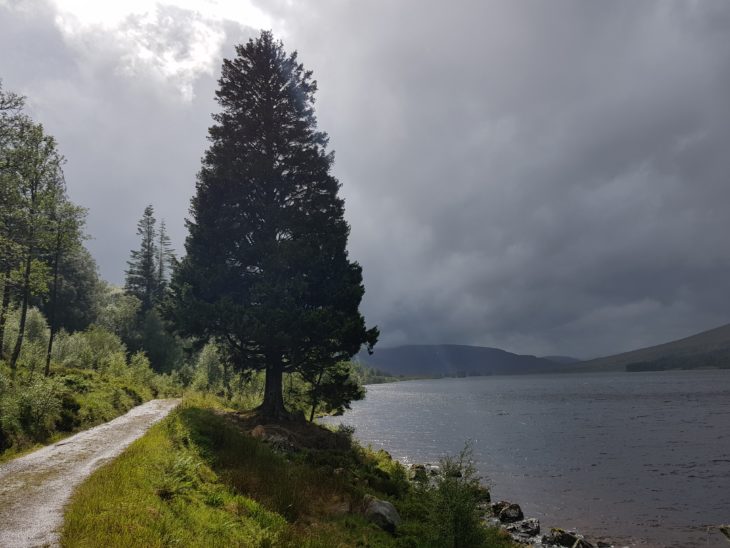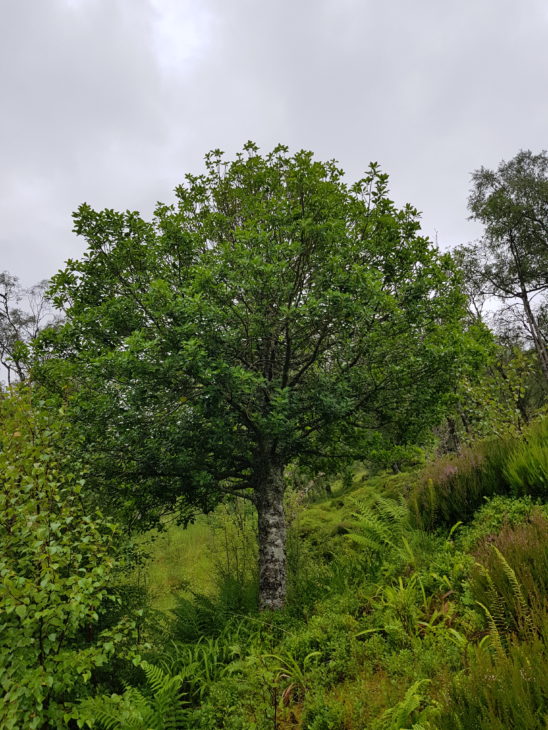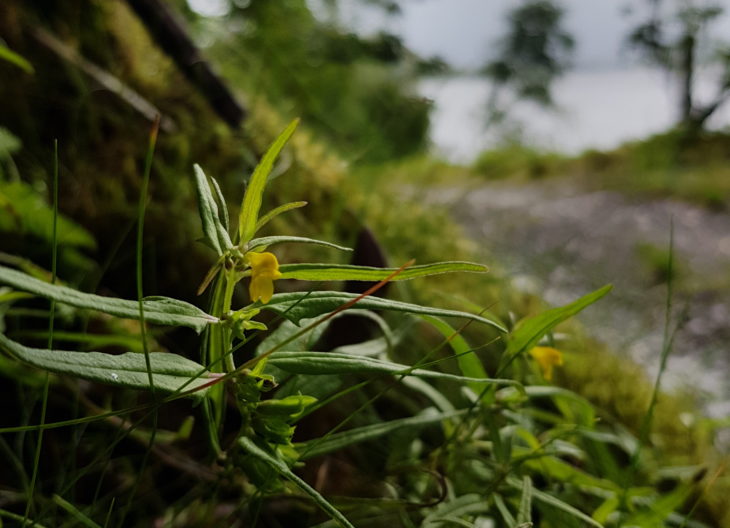Leading the charge at Corrour Estate
Introduction by Jonny Hughes.
In our Living Landscapes in the Scottish Uplands and 50 for the Future publications, we suggested a number of actions that could radically improve the denuded ecology of the Scottish uplands. These included:
- Reducing wild deer densities substantially to allow the widespread recovery of natural woodland and scrub (read the 50 for the Future article here)
- Transforming large conifer plantations so over half contain at least 25% native species and a diverse range of tree ages, from saplings to future veteran trees (read the 50 for the Future article here)
- Restoring all peatland blanket bogs to secure valuable carbon storage, water quality and biodiversity benefits (read the 50 for the Future article here)
Given much of the Highlands are owned by private estates, achieving these actions on any meaningful landscape-scale will, in large part, depend on the will of estate owners to change their current management practices. Whilst smarter government policy and regulation may help, in the end this change will only happen if the culture of Highland estates shifts fundamentally from an extractive model to a stewardship model.
The good news is there is a small but growing group of estate owners who are excited about creating this change, and who are leading the charge by restoring denuded habitats on their own landholdings.
One of those estates is Corrour, on whose board I sit as a non-executive director. What Corrour is doing is extraordinary. As you will see in the guest blog below, written by the estate owner Lisbet Rausing, the team at Corrour are making great strides in reducing deer densities, transforming large plantations and restoring peatlands.
I believe that the leadership being shown at Corrour, and other pioneering estates like Ardtornish in Morven and Wildland Limited in the Cairngorms, will in the coming decade inspire other estate owners to embrace the cultural change we need to recover the lost nature of our mountains and glens.
A short history of Corrour Estate
by Lisbet Rausing
Our family are newcomers to the Highlands. We bought Corrour in 1995 from Donald Maxwell MacDonald, grandson of Sir John Stirling Maxwell, who in turn bought Corrour in 1891, at age 25. Sir John was a philanthropist and benefactor, as well as a pioneering botanist and forester. He ringed Loch Ossian with, effectively, an arboretum, and he planted a 60-acre large rhododendron garden with specimens his plant hunters collected in the Himalayas. Sir John was a caring employer, too: Corrour’s staff houses were beautifully and solidly built. They even had indoor bathrooms, which was exceptional in the 1890s. The lodge he built in 1896 (lost in a fire in 1942) was pleasantly plain, eschewing Scottish baronial fancies. As a tenth baronet, he had no need for fantasies.
Our family were enchanted by the Scottish mountain landscape, as Nordics are (we grow up reading Gavin Maxwell). And one magical summer in the early 1980s, our family rode across the Highlands. It was a journey we never forgot.
West Coast place names reminded us that these were lands that our ancestors had settled. Torlundy outside Fort William echoes Sweden’s many Torlunda. Lochaber too once had sacrificial groves, where Tor, the Norse god of war and thunder, was worshipped.
We noted that Somerled (?-1164), king of the Kingdom of the Isles, descended from Norsemen, and is the ancestor of the five chiefs of Clan Donald. Later we learnt that genetic studies show he has some 500,000 patrilineal descendants. If you are a MacAlister, a MacDonald, or a MacDougall, chances are that–via your forefather Somerled–you have Norwegian ancestry. No wonder our family felt at home in Scotland!
Even the name of Somerled’s wife, Ragnhild, was a familiar echo of our women’s names, like Gunhild or Sigrid. But we knew, of course, that Highlands and Islands lineages and histories were contested and complexly layered. “Somerled” means “summer traveller” in Norse. It is an uncanny reminder that the Vikings so enjoyed their summer raids they named their sons in celebration of them.

Our family felt at home in Lochaber from the start. But at first, we didn’t know what we saw. Over time, and thanks to our new Scottish friends, we understood that Corrour was an ancient common: high altitude, summer cattle-grazing land for the people of the glens. My mother Märit recognized this as the fäbodsmarker she grew up with before the War, in Jämtland and Hälsingland, Swedish counties at northern-most edge of farmed Europe. She still remembers “little cows running around in the forest.”
Slowly we began to piece together how Corrour is a cultural landscape. From deep antiquity on, we learnt, it was a vast wood pasture, with altitudinally layered—and thus diverse–plant communities. Yet when we came in 1995, just 39 of Corrour’s 23,000 hectares were natural woods. The altitudinal tree line had vanished altogether. Even understory vegetation like heather, bilberries and cowberries was largely gone. Those spongy and mossy hummocks and knolls, diverse and colourful, had given way to hard-trampled ground, covered, at best, by heather, or else by deer grass.
True, Corrour had some luck, as it swerved and careened towards its modernity. On the open hill, its peat bogs were not drained and ditched. Nor was heather habitually burnt. But overgrazing had still led to extensive erosion gullies across open hill peatlands. And Corrour’s lower hill side was ditched and drained when, from 1966 to 1984, the Forestry Commission erased 3,500 hectares of this cultural landscape from deep Celtic antiquity.
It took 18 years to destroy a millennia-old land. Once it was a complexly mosaic, savannah-like landscape, with sessile oak, downy birch, rowan, alder, aspen, wild cherry (gean), willows, ash, holly, hazel, and juniper (all with associated flora, fungi, insects, mammals and birds). Now it was replaced by a radically simplified cropland.

These giant fields of three-four exotic conifers, mostly lodge pole pine and sitka spruce, were abandoned after they were planted– never thinned, and rarely deer-culled. Much is now diseased, dead, or windthrown. Across lower Corrour, stunted, yellowed conifers show the folly of planting on deep peat bogs. We found a few last ancient oaks in these gloomy conifer croplands, their spreading branches seemingly embracing the now-lost community pastures they once guarded.
You will have seen the ruined shielings across the Highlands. That is where, in the summers, clan women milked cows and made cheese, while in the glens below the men harvested hay, to feed the stock across long winters. This traditional vertical transhumance, where livestock seasonally migrate up and down mountains, was once common across Europe’s mountain regions. It is still practiced today in the Alps, the Pyrenees, the Carpathians, the Caucasus, and the Norwegian-Swedish fjäll mountains.
In continental Europe, transhumance is joyfully ritualized, with flower-bedecked cows, celebratory processions, and church blessings. Yet it is no longer practiced in Scotland. Why? What happened to Corrour, cared for since the beginnings of time by the Keppoch MacDonalds?
In brief, from 1707 on, and under the new British rule, Scottish customary over-lordships, which were once polite indication of time-worn hierarchies of honour, hardened into absolute property rights. The clans lost out, as land became detached from customary uses and responsibilities, to become a tradable commodity. Thus, in 1834 the dukes of Gordon were able to sell the Loch Treig estates, and thereby what is now Corrour. In the decades thereafter, the now alienated land took its typical Highland turn, to sheep-run and deer forest. Over-grazing, both in terms of stock density and stock staying on the land all year round, ensured that tree generation ceased and ground flora simplified, into ever fewer plants.
Add to this, the so-called “Victorian holocaust.” Common across the Highlands, it befell also Corrour. The term refers to that remarkably thorough, and uniquely British, extermination of all fauna, except one or two favoured game species–at Corrour, red deer and grouse. Late 19th and early 20th century Corrour game books record how, to use the vocabulary of the time, “sportsmen” at first recorded vast bags of “vermin,” and then, in later years, next to nothing, as wild fauna grew exceedingly rare, or locally extinct. God’s creatures were shot, snared, trapped and poisoned: golden eagles and sea eagles, alongside all other birds of prey including owls; foxes, stoats, weasels, pine martens, wild cats, and otters; red squirrels, rabbits and mountain hares; capercaillie and black grouse; black swans, waders, ducks, and geese; and even jays and ravens (and indeed all corvids).
When we came to Corrour in 1995, there was little left to shoot. A few generalist mesopredators hung on, like foxes and hooded crows. They were still fiercely persecuted, at a marginal cost in man-hours that had not even the remotest relation to the additional income of an extra hill lamb or two (or the cost of lambing sheds).
Apex predators have long been eradicated across the Highlands. Wolves were shot out in the 18th Century, while lynx and bears disappeared already from the medieval landscape. Other keystone species, too, have vanished. Until the early modern period, beavers hung on. Indeed, it is believed that the valley now flooded for Loch Treig, on Corrour, was their last British stronghold. It is heartening to see them now return to Scotland.
Another essential ecosystem engineer and British native, the wild boar, is returning to Lochaber, too, though the Scottish shooting fraternity has renamed it “feral pig” and many argue it needs to be eradicated, despite it being an excellent game species and a vital component of woodland ecology.
At Corrour, our most important Scottish mentor was Dick Balharry, then chair of the John Muir Trust. In 2007, Dick helped us draw up a management plan that focused on whole habitats and on allowing natural processes to take place, and on being guided by habitat response. We made a baseline assessment of habitats then, and have measured progress since. At first, we worked only on land. From 2015 on, thanks to Nick Ferguson’s suggestion, we also started to survey fish, aquatic invertebrates and aquatic plants.

Today, we do not “control” predators or “vermin.” We are reducing deer numbers from c. 20 per square kilometer to under five. This allows natural regeneration of ground flora and trees. And it betters deer health and welfare. (We do not winter feed our deer. But nor do we want starvation to regulate deer numbers). We leave gralloch and some carcases on the hills for eagles, ravens and pine martens. And in 2006, to rest the land, we agreed with George Nairn at Fersit to remove his flock of 350 ewes (with lambs). Today Mr Nairn’s beef cattle – mothers and calves – roam across Corrour in summers, echoing past transhumance.
Some native wildwoods are reverting naturally, for example among our windfallen exotic plantations, or along the railroad line. Where seed banks are poor or soils exhausted, we plant new native woodlands. And where we fell commercial conifers, and have replanting obligations, we replant with native Scottish trees. We are also restoring peat bogs. And we have reintroduced hedgehogs and red squirrels.
We couldn’t restore Corrour’s ecology alone. We are hugely grateful to our partners and friends, including John Muir Trust, Scottish Natural Heritage, Lochaber Fisheries Trust, Tom Christian and the Royal Botanic Garden Edinburgh, John Hammond and the Rhododendron Species Conservation Group, Ron Greer, Bill Mason, Gary Servant, Ian Strachan, the Forestry Commission Highland Conservancy, Roy Dennis, David Hetherington, Jonny Hughes, and Hugh Raven.
The Corrour team deserve huge praise, too. They rise to all challenges (and remote estates have a fair few!) with professionalism, domain expertise, and a positive, constructive spirit.
At Corrour, we also welcomed the Land Reform Act (Scotland) 2003. It echoes Sweden’s allemansrätt, which since medieval times ensures all people are welcome to walk the land, picnic, camp, swim, climb trees, pick berries, collect firewood, and the like. Children need to be free range, too!
When we arrived in 1995, we were surprised to learn that Scottish people were banned from roaming across what to many was their own ancestral clan lands, and to all Scots, their home land. We failed to follow our fellow landowners’ arguments as to why “all men’s rights” must be opposed. Instead, another new-found friend, Dave Morris Macintyre, then head of the Ramblers’ Association, helped us think through Corrour’s path networks and how we can best welcome people. Today Corrour welcomes more than 12,000 walkers each year.

All Corrour estate buildings are renovated and maintained. We rebuild and restore our cottages using traditional methods and local materials, but improve their energy performance. We retain the historic groupings of buildings. Around them, we garden naturalistically, without pesticides, herbicides, fungicides, or chemical fertilisers. We offer our twelve estate workers and their families high-quality housing on the estate, in Corrour village and – closer to schools – at Moy and Luiblea, 12 miles down, by the road.
We let the lodge and eight holiday cottages, offering visitors the opportunity to explore Corrour’s glorious landscapes. Since 2016, we also offer three en-suite rooms in the newly renovated, historic Signal Box, located on the Corrour train station platform, next to the Station House, where we run an inn and a shop. The Signal Box gives people with limited mobility who do not own cars a chance to holiday in a remote wilderness.
We always wanted to protect Corrour’s future independence and stability. After all, industrial fortunes come and go. And it is not healthy or safe for a local community to be subsidised from elsewhere. For years, we saw no prospect of doing so. It worried us, since estates like Corrour are hugely expensive to run. But now, we have built four hydro-electric ‘run-of-river’ schemes. They will never make a fortune. But thanks to British governmental green subsidies, they are viable. We don’t know how they will be taxed in the future. But hopefully, they will allow Corrour to stand on its own two feet, paying for our environmental work, welcoming visitors, and providing good jobs in the local community.
Our hydro-schemes also provide enough green, renewable energy to power Corrour, and, via the National Grid, 3,500 homes. At times of low river flow – during droughts or when the rivers freeze – the hydros automatically shuts down, to preserve the natural ecology of the burns. The smaller turbine houses and other hydro buildings are crafted from locally-quarried Achnasheen stone, in the Scottish rural vernacular style. It was not cheap. But it helped keep a local craft alive, and it pays respect to the Highland’s landscape and history. Our largest hydro scheme, Ghulbinn, is built in the tradition of early twentieth century Scottish power stations, reflecting its relative scale.
Corrour is our family’s greatest joy. We hope to have the good fortune to help protect and care for it for many generations yet, together with its stakeholders, in a transparent spirit of co-operation, trust, and respect.
We are grateful to Scotland for having generously welcomed us. And we will always remember, with especial gratitude, the first people who reached out to us with warmth and friendship, Patrick Gordon Duff Pennington, and Richard and Janet Sidgwick.
Jonny Hughes is the Chief Executive of the Scottish Wildlife Trust and a non-executive director of Corrour Estate.
Lisbet Rausing is the owner of Corrour Estate, author of a scholarly biography of Carl Linnaeus Linnaeus: Nature and Nation (1999) and a senior research fellow at King’s College, London.
Help protect Scotland’s wildlife
Our work to save Scotland’s wildlife is made possible thanks to the generosity of our members and supporters.
Join today from just £4 a month to help protect the species you love.
Preface
Introduction by Jonny Hughes. In our Living Landscapes in the Scottish Uplands and 50 for the Future publications, we suggested a number of actions that could radically improve the denuded ecology …
